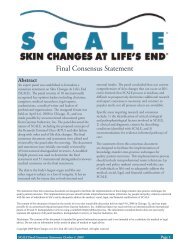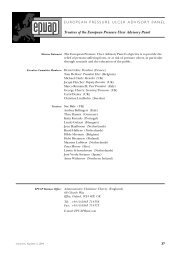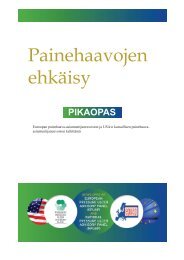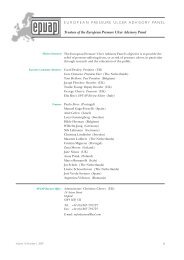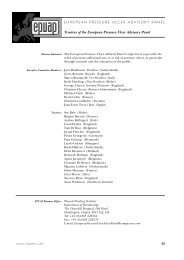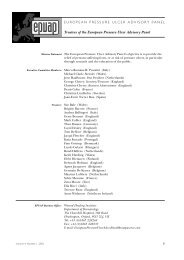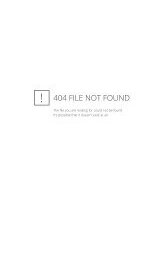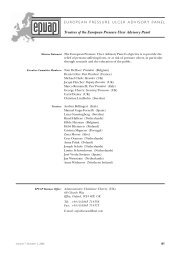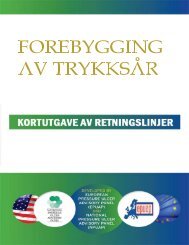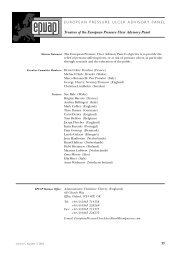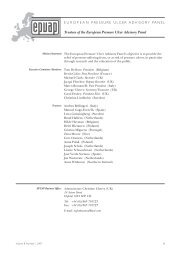EPUAP Review 5/2 RIP - European Pressure Ulcer Advisory Panel
EPUAP Review 5/2 RIP - European Pressure Ulcer Advisory Panel
EPUAP Review 5/2 RIP - European Pressure Ulcer Advisory Panel
You also want an ePaper? Increase the reach of your titles
YUMPU automatically turns print PDFs into web optimized ePapers that Google loves.
Source of Evidence that underpins the recommendation<br />
I Evidence from systematic review or meta-analysis of<br />
randomised controlled trials or at least one<br />
randomised controlled trial.<br />
II Evidence from at least one controlled trial without<br />
randomisation or at least one other type of quasiexperimental<br />
study.<br />
III Evidence from non-experimental descriptive studies,<br />
such as comparative studies, correlation studies and<br />
case-control studies.<br />
IV Evidence from expert committee reports or opinions<br />
and/or clinical experience of respected authorities.<br />
Recommendation Grading<br />
A Directly based on category I evidence.<br />
B Directly based on category II evidence or extrapolated<br />
recommendation from category I evidence.<br />
C Directly based on category III evidence or extrapolated<br />
recommendation from category I or II evidence.<br />
D Directly based on category IV evidence or extrapolated<br />
recommendation from category I, II or III<br />
evidence.<br />
Both grading systems were adapted from Eccles M, Mason J<br />
(2001). How to develop cost-conscious guidelines. Health<br />
Technology Assessment 5: 8.<br />
Structure of the Guideline<br />
The recommendations of this guideline are considered to<br />
apply to both the prevention and management of pressure<br />
ulcers. Where guidance relates solely to pressure ulcer treatment<br />
this will be highlighted in the text. It should also be<br />
noted that the <strong>EPUAP</strong> considers all recommendations to<br />
be equally valid regardless of the grade of evidence upon<br />
which they are based. In the following recommendations<br />
where a source and level of evidence is not explicit, the<br />
recommendation should be considered as a level IV, D recommendation.<br />
Screening and Assessment of Nutritional Status<br />
Screening and assessment of an individual’s nutritional status<br />
can be performed using a number of measures ranging<br />
from tools such as the Subjective Global Assessment (Detsky<br />
et al., 1987) to relatively simple measures of height and<br />
weight (combined as Body Mass Index). However, some<br />
measurements (height, laboratory tests, skin fold thickness)<br />
may not be readily available in all care settings. Undesired<br />
weight loss (>10% of normal body weight in the past six<br />
months, or >5% in the past month) may provide an indication<br />
of malnutrition although where possible reasons for<br />
this unintentional weight loss should be explored with the<br />
individual patient.<br />
Accurate measurement of body weight and height, and<br />
hence Body Mass Index, may be problematical in many settings<br />
through lack of available equipment or challenges in<br />
measuring body length among some patient groups. While<br />
BMI has been found to be less valid in some patient groups,<br />
such as children and the very elderly, due to an altered/<br />
different fat/lean body mass ratio.<br />
Nutritional assessment may also include nutritional in-<br />
REPORT FROM THE GUIDELINE DEVELOPMENT GROUP<br />
take over the past 1, 3 or 7 days; this information may be<br />
gathered using 24-hour recall, self or carer reported food<br />
intake records or through the involvement of a dietician,<br />
where available. It is important to consider why the intake<br />
of food and fluids is at the reported level.<br />
Biochemical measurements such as serum albumin,<br />
hemoglobin and potassium may be helpful when considering<br />
the nutritional status of the ill although these indicators<br />
may provide more information upon chronic, rather<br />
than acute depletion of specific nutrients. In general it is<br />
unlikely that biochemical measurements will provide more<br />
information than other indicators such as undesired weight<br />
loss although a number of studies cite an association between<br />
albumin and pressure ulcers.<br />
The use of nutritional screening or assessment tools<br />
appears to be becoming more prevalent in managing patients<br />
at risk of/with pressure ulcers. These tools require to<br />
be validated and reliable, and like general risk assessment<br />
tools should not replace clinical judgement. However, the<br />
use of validated nutritional assessment tools may help to<br />
foster attention upon the need to consider nutrition when<br />
assessing vulnerability to pressure ulcer development.<br />
Nutritional status should be re-assessed regularly following<br />
an individualized assessment plan which includes an<br />
evaluation date. The frequency of assessment should be<br />
based upon the condition of the individual and should occur<br />
following specific events such as surgery and any development<br />
of infections or other catabolic processes likely to<br />
stress the nutritional status of the individual.<br />
While looking at the individual patient the clinical judgement<br />
of appropriately trained health professionals may provide<br />
sound evaluations of probable nutritional status, it<br />
should be acknowledged that excess of body weight may<br />
mask nutritional deficiencies – for example morbidly obese<br />
individuals may still be malnourished.<br />
Nutritional Intervention<br />
Where an assessment or screening of nutritional status indicates<br />
that malnutrition may be present, nutritional intervention<br />
should be considered. The primary goal of nutritional<br />
intervention is generally to correct protein-energy<br />
malnutrition ideally through oral feeding. When considering<br />
any limitations on normal food and fluid intake, consider<br />
the local environment such as ease of access to food,<br />
social and functional issues along with the texture of the<br />
diet. Changes in these aspects may encourage or facilitate<br />
increased oral intake. Overall the goal should be to consider<br />
the quality and energy-density of the food intake rather<br />
than its quantity. Considering fluid intake quantity is equally<br />
important as quality.<br />
Where enhanced normal feeding is not possible, protein-energy<br />
rich oral supplements may be considered (Recommendation<br />
1, B; Benati et al., 2001, Bourdel-Marchasson<br />
et al., 2000, Breslow et al., 1993, Chernoff et al., 1990, Delmi<br />
et al., 1990). The value of vitamin and trace element supplementation<br />
in pressure ulcer prevention is unclear (Recommendation<br />
1, B; Taylor et al., 1974, ter Riet et al., 1995).<br />
Where normal feeding and oral supplementation fail<br />
to resolve apparent malnutrition then other routes (for<br />
example tube-feeding) may be undertaken although the<br />
risks associated with these interventions should be considered.<br />
Volume 5, Number 2, 2003 51



